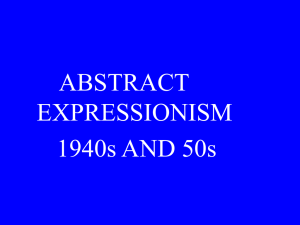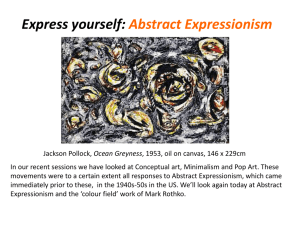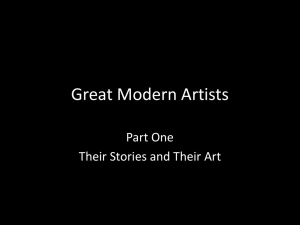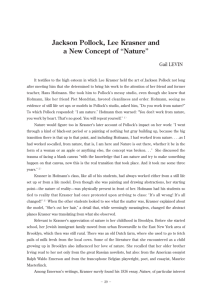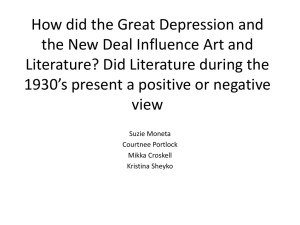File
advertisement
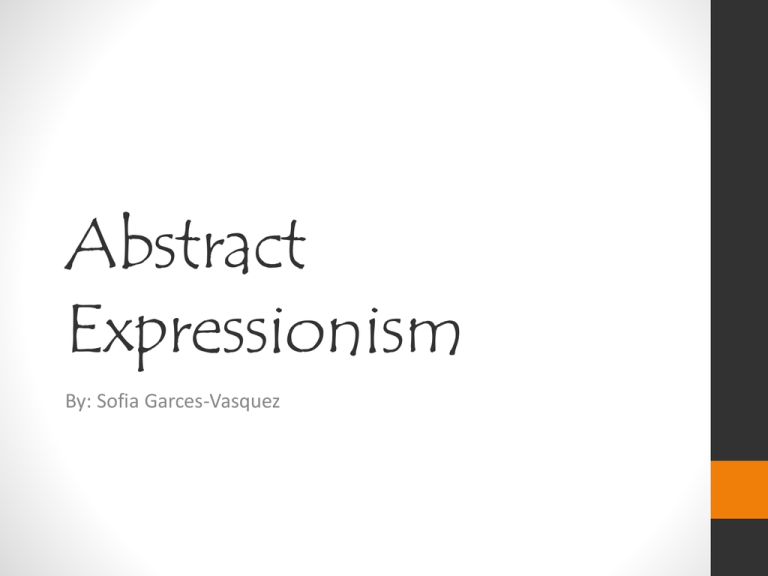
Abstract Expressionism By: Sofia Garces-Vasquez What is it? Abstract Expressionism is the name for an artistic movement that grew in the USA (1940) (1950) shaped by the legacy of surrealism . It is also known as the New York School, since most artists who had fled the fighting and persecution in Europe ended up in New York. The abstract expressionist group was made up of artists who had either come from Europe or who were directly influenced by the movements, styles and techniques How is it Abstract? This movement was translated into a new style fitted to the post-war mood of anxiety and trauma. Expressionist artists used bold colours and lines to strong feelings and emotion . This style is different from figurative or realist art. Where the artist tries to recreate the appearance of actual objects or people these artists reduce things from the real world to basic shapes and forms or create new forms from their imagination. This form of art is also influenced by surrealism. The surrealist tried to express the subconscious using symbolic and dream like images. While abstract expressionists expressed things through the actual process of painting. Before Abstract Expressionism many artists did not value American art as much as European art. Some copied its style while others painted realist images of life. In the rural and urban united states the recognition of the Abstract Expressionist meant that for the first time the USA became known as an important force in avant-garde art, avantgarde is a term used for anything radically new or different. While the abstract expressionists were influenced by European art, they created something entirely new and created trends rather then follow them. How is It formal? A paintings form is composed of its basic elements: colour, line, composition and texture. This elements contain the fundamental language to examine and analyze works of art. Whether an artwork is pure abstraction or representational, formalism looks for the same basic elements and judges a paintings value based on the artists ability to achieve a cohesive balance in the composition. If a painting is deemed deficient in value, it is because the artist failed to create a visual balance of the formal painterly values. When creating expressionism, the artist seeks to depict not objective reality but rather the subjective emotions and responses that objects and events create in a person. This can be accomplished through distortion, exaggeration, primitivism and fantasy and through the vivid, jarring, violent or dynamic application of formal elements Action painting Also known as Gestural Abstraction. It is a style of painting in which paint is spontaneously dribbled, splashed or smeared onto the canvas, usually placed faced up on the floor. rather then being carefully applied. Although This technique has been used by different artists involved in different movements, it is principally associated with the New York School of American Abstract Expressionism . The name Action Painting was first used in 1952 by the American critic Harol Rosenberg, according to him Action Painting gave complete freedom to the painters creative impulses, and made the act of painting more important then the work itself Arshile Gorky He was an American painter who had a fatherly influence on the creation of the Abstract Expressionism art movement. He created a crucial bridge between surrealism and Abstract Expressionism. The actual date of his birth is unknown, it was somewhere between 1902 and 1905 therefore he was always vague about his birthday and he would change it from year to year. Gorky hit on the idea of becoming a great painter by practicing painting in the style of Paul Cezzane, Joa Miro, and Pablo Picasso. He was particularly interested in Pablo Picasso’s synthetic cubism. At the end of 1920s and into the 1930s he experimented with cubism, eventually moving to surrealism. His aim was never to imitate the work of others however, but to learn their form, their aesthetic ideas, and then evolve beyond it From 1026 to 1931 he taught the grand central school of art and influenced many young artists with his theories about abstraction. At the age of 31 he married and changed his name to Arshile Gorky, in the process of reinventing his identity he told people he was relative of the Russian writter Maxim Gorky, and started lying about his age and date of birth. He like passing himself off as a successful Russian portraits who had studied in Paris and experimented with Automatism. Gorky’s final years were a soap opera of intense pain and heartbreak. He achieved personal success and fame, but his studio burnt down in 1946, and he lost many of his paintings. He also had surgery to remove his throat cancer. In June 1948 his neck was broken and his painting arm temporarily paralyzed in a car accident. In July his wife of seven years, left him taking his children with her. On july 21st, 1948 Gorky hanged himself in Sherman at the age of 44 Some of his work… The Artist and his Mother 1926 Self Portrait at the Age of Nine -1928 Night Time Enigma and Nostalgia - 1932 Organization - 1933 Wassily kandinsky Born on Dec 16 1866 in Moscow in a family of business man, his parents wanted him to become a lawyer so he entered the law faculty of Moscow university and graduated with honours, six years later he married his cousin. In 1896 he decided to give up his successful career to devote himself completely to painting, in 1900 he entered the Munich Academy of Arts, where he met Gabriella munter and divorced his wife, five years later, he with Gabriella traveled across Europe, and they settled down in a small town at the bottom of the Alps. In 1901 he founded Phalanx, an art group and started a school where he taught himself. When the world war began, him and his wife moved to Switzerland where he started to work on a book, November Gabriella went back to Germany. In 1916 he got acquainted with the daughter of the Russian General and he married her in February 1917 During this years of revolution Kandisnsky alternated between half abstract idiom, impressionist landscapes and romantic fantasies. He returned to Germany in 1921, there he taught the school or art and architecture from 1922 until the Nazis closed it in 1933. he then moved to France, where he lived for the rest of his life Some of his work… White Dot- 1923 Oil Paint Composition VIII Oil Paint Braunlich (Brownish) 1931 Oil Paint Jackson Pollock Born January 28, 1912, in Cody. Jackson pollock studied under Thomas Hart Benton before leaving traditional techniques to explore abstraction, expressionism via his splatter and action pieces, which involved pouring paint and other media directly onto the canvas. Pollock was both renowned and critiqued for his conventions. He died after driving drunk ad crashing into a tree in New York in 1956, at age 44 During the Depression, President Franklin D. Roosevelt started a program called the Public Works of Art Project, one of many intended to jumpstart the economy. Artists such as Pollock were given $24.86 to do 20 hours of work a week. The program resulted in thousands of works of art by Pollock and contemporaries such as José Clemente Orozco, Willem de Kooning and Mark Rothko. But despite being busy with work, Pollock could not stop drinking. In 1937, he began receiving psychiatric treatment for alcoholism from a Jungian analyst who fueled his interest in symbolism and Native American art. In 1939, Pollock discovered Pablo Picasso's show at the Museum of Modern Art. Picasso's artistic experimentation encouraged Pollock to push the boundaries of his own work. Pollock’s most famous paintings were made during the “drip Period” 1947-1950. he became very popular after being featured in a four page spread on Aug 8, 1949, in life magazine. This article changed Pollock’s life over night, many other artists resented his fame, and his friends suddenly became competitors . As his fame grew he began to question his own work. In 1950 his show at Betty Parsons Gallery sold out, and he suddenly became the best paid painter in America. Pollock’s fame made him become dismissive of other artists, even his former teach A documentary Photographer began producing a film of Pollock working , Pollock found It impossible to perform in front of the camera. Instead, he went back to drinking heavily Pollock's 1950 show at the Parsons gallery did not sell, though many of the paintings included, such as his "Number 4, 1950," are considered masterpieces today. It was during this time that Pollock began to consider symbolic titles misleading, and instead began using numbers and dates for each work he completed. Pollock's art also became darker in color. He abandoned the "drip" method, and began painting in black and white, which proved unsuccessful. Depressed and haunted, Pollock would frequently meet his friends at the nearby Cedar Bar, drinking until it closed and getting into violent fights. Concerned for Pollock's well-being, Krasner called on Pollock's mother to help. Her presence helped to stabilize Pollock, and he began to paint again. He completed his masterpiece, "The Deep," during this period. But as the demand from collectors for Pollock's art grew, Overwhelmed with Pollock's needs, his wife was also unable to work. Their marriage became troubled so he started dating other women, and by 1956, he had quit painting, and his marriage was in shambles. Krasner reluctantly left for Paris to give Pollock space. Just after 10 p.m. on August 11, 1956, Pollock had been drinking and he crashed his car into a tree less than a mile from his home, his girlfriend at the time, was thrown from the car and survived. Another passenger was killed, and Pollock was thrown 50 feet into the air and into a birch tree. He died immediately. His wife returned to bury Pollock, her mourn Retained her creativity and productivity, Krasner lived and painted for another 20 years. She also managed the sale of Pollock's paintings, distributing them to museums. Before her death, Krasner set up the Pollock-Krasner Foundation, which gives grants to young, promising artists. When Krasner died on June 19, 1984, the estate was worth $20 million. Summertime: Number 9A 1948 Oil, enamel and house paint on canvas Mural 1943 Willem de kooning Gotham News 1955 Rider (Untitled-VII) (1985) Untitled 1949 Works Cited • http://www.britannica.com/EBchecked/topic/198740/Expressi onism • http://www.theartstory.org/definition-formalism.htm • http://en.wikipedia.org/wiki/Action_painting • http://www.visual-arts-cork.com/history-of-art/actionpainting.htm • http://www.arthistoryarchive.com/arthistory/abstractexpressi onism/Arshile-Gorky.html • http://www.wassilykandinsky.net/ • http://www.biography.com/people/jackson-pollock9443818#downfall-and-death • https://www.youtube.com/watch?v=x8ZgxvW8otQ
